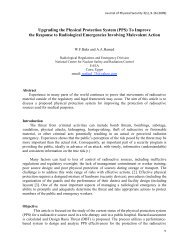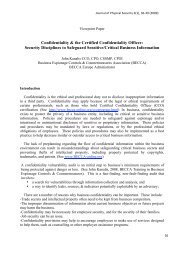PDF - The Journal of Physical Security - Argonne National Laboratory
PDF - The Journal of Physical Security - Argonne National Laboratory
PDF - The Journal of Physical Security - Argonne National Laboratory
Create successful ePaper yourself
Turn your PDF publications into a flip-book with our unique Google optimized e-Paper software.
<strong>Journal</strong> <strong>of</strong> <strong>Physical</strong> <strong>Security</strong> 4(2), 30‐34 (2010)Viewpoint PaperBeing Vulnerable to the Threat<strong>of</strong> Confusing Threats with Vulnerabilities*Roger G. JohnstonVulnerability Assessment TeamNuclear Engineering Division<strong>Argonne</strong> <strong>National</strong> <strong>Laboratory</strong><strong>The</strong> following ideas are common, but I think quite wrong and thus myths:(1) A Threat without a mitigation is a Vulnerability.(2) A Threat Assessment (TA) is a Vulnerability Assessment (VA).(3) Threats are more important to understand than Vulnerabilities.(4) Many <strong>of</strong> the most common tools used for “Vulnerability Assessments”(whether true VAs or actually TAs) are good at finding Vulnerabilities.First some definitions. Most security pr<strong>of</strong>essionals would probably more orless agree with the following definitions:Threat: Who might attack against what assets, using what resources, withwhat goal in mind, when/where/why, and with what probability. <strong>The</strong>re mightalso be included some general aspect <strong>of</strong> the nature <strong>of</strong> the attack (e.g., carbombing, theft <strong>of</strong> equipment, etc.), but not details about the attack or thesecurity measures that must be defeated and the Vulnerabilities to be exploited.Threat Assessment (TA): Attempting to predict the Threats. This mayinvolve using intelligence data and information on past security incidents (atthis building, facility, or infrastructure or ones like it.) To have proactive (notjust reactive) security, however, a valid TA requires anticipating Threats thathave not yet materialized.________________________________________________*Editor’s Note: This paper was not peer-reviewed. This work was performed under the auspices <strong>of</strong> theUnited States Department <strong>of</strong> Energy (DOE) under contract DE-AC02-06CH11357. <strong>The</strong> views expressedhere are those <strong>of</strong> the author and should not necessarily be ascribed to <strong>Argonne</strong> <strong>National</strong> <strong>Laboratory</strong> orDOE. Jon Warner provided useful suggestions.30





